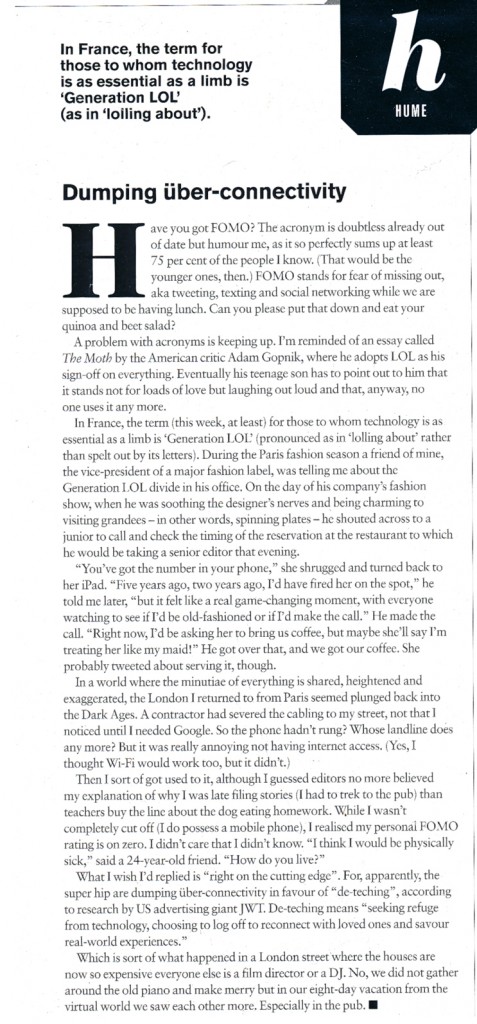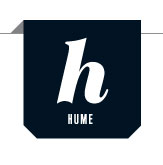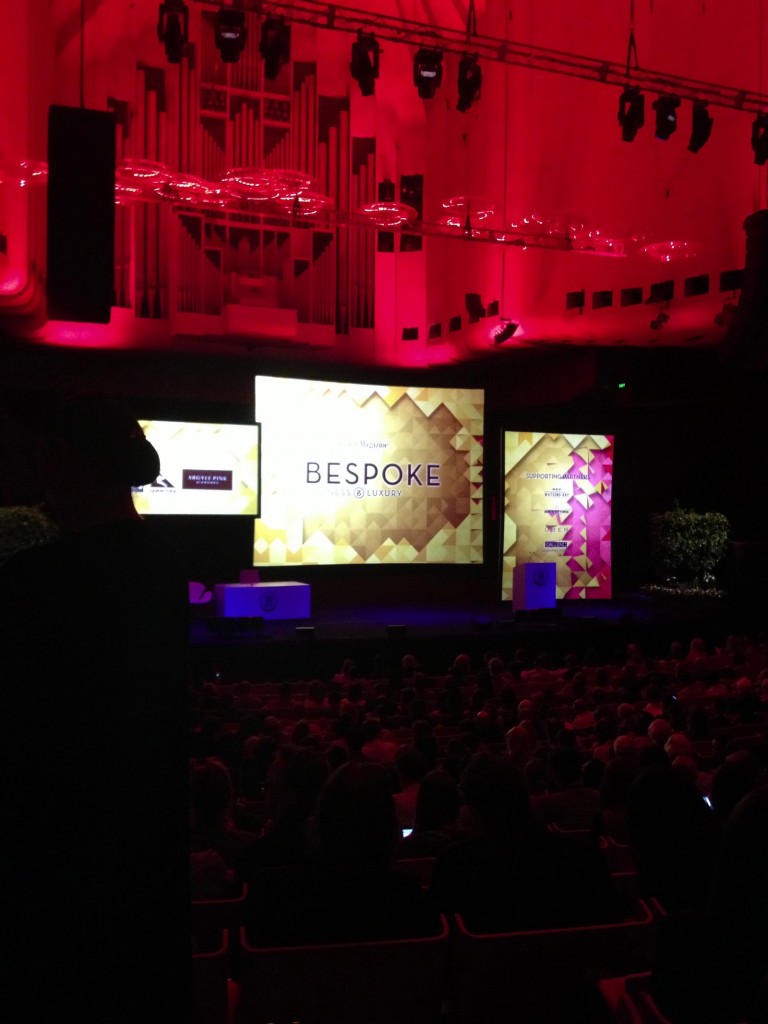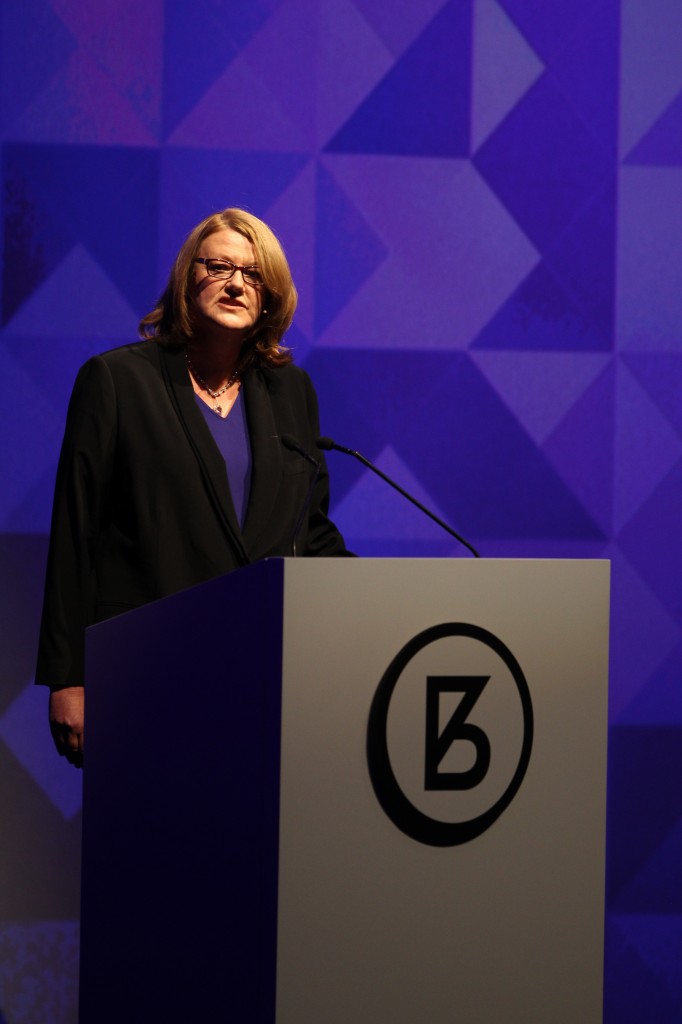For Costume Parties Only – AUSTRALIAN FINANCIAL REVIEW
by Marion Hume
Now that the brouhaha about The Great Gatsby has settled — at least until it ramps up again for movie awards season — shall we take a moment to examine its sartorial legacy? As in, does it have one? Or does it not? You’d think the answer would be easy. Count the glossy pages devoted to “Gatsby style” in the past months. But is there now a taste for flapper dresses in a shade I still like to call “Queen Mum mauve”? Have oyster satin pyjamas moved from boudoir to street? For gentlemen, have pink suits taken off? The answer — to all — is no.
What is beyond reasonable doubt is that double Academy Award-winning costume designer Catherine Martin is on track for her third Oscar, for her fearless mixing of the historically accurate with the utterly contemporary. But when the looks filter down, what we have is fun, not fashion. The reason ‘20s style is the perpetual party theme that is so easy to do — with something spangly, a gold T-bar shoe and a cheap wig. Almost every woman looks like she’s having a good time when you add a feather boa.
A few years ago, I was reminded of the power of ‘20s dressing thanks to Eyjafjallajokull. Remember the volcano erupted? To cut one of my all-time favourite stories short, I was halfway through airline online check-in when I realised I needed a swift plan B to reach Venice. I hitched a ride on the Orient Express, a fun-filled flapper heaven (other than for me: I didn’t have time to theme-pack). The only mirrors on board are make-up sized, which means no one has a full-length view. Everyone thus dresses how they think they would like to look and, thanks perhaps to some dry martinis, everyone looks lovely. Not fashionable, but superbly theme-party lovely.
What is lovely is how loudly Catherine Martin has acknowledged the roles Tiffany & Co, Prada and Brooks Bros played in her overall costume creation. When she brings her Oscar count to a trifecta, I’ll wager that, once she’s effusively thanked her collaborator in life and work, the film’s director Baz Luhrmann, she will name-check all the above. By so doing, Martin will be acting more than graciously — she will be setting right a wrong done when The Great Gatsby last garnered an Oscar, in 1974. If you recall that version at all, what you’re most likely to remember is Robert Redford’s clothes (Mia Farrow’s Daisy is a more misty memory). Yet when costume designer Theoni Alderedge caressed her Oscar at the podium, she did not thank Ralph Lauren, an omission that made clear the attention he had been getting for his suits had got right under her skin.
Aldredge was not the first costume designer to neglect to thank the input of fashion designers. When Edith Head collected an Oscar for Sabrina (1954), she seemed not to recall that French couturier Hubert de Givenchy was responsible for the new neckline that so flattered elfin Audrey Hepburn, igniting a trend. Givenchy didn’t stake his claim to the “Sabrina neckline” until years after Head’s death, even though those who’d worked with her at Paramount Pictures had, by then, confided that the costumes had been made up from Givenchy’s sketches.
As to the current Gatsby changing the way we dress, I doubt it. But acknowledging that you need creative collaboration to make something great? Well, that’s bang on trend.
Bespoke Luxury Summit brings fashion icons together in Sydney
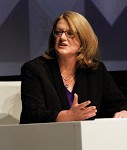 Bespoke Luxury Summit brings fashion icons together in Sydney
Bespoke Luxury Summit brings fashion icons together in Sydney
The Australian Financial Review | May 2013
For me, fashion is always about vision. That doesn’t fit in a basement, no matter how snazzy the chandeliers. When the idea of an Australian Financial Review luxury business conference was first mooted, the least interested person was me. Nothing inspires me less than the thought of spending an airless day listening to guys in ties drone on to a backdrop of PowerPoints. Maybe – if the facts are fascinating and your business is finance or mining – that floats your boat.
To succeed we had to be bold. So the AFR Bespoke Luxury and Fashion Summit, held on Thursday, was inspired by the most audacious example, the Sydney Opera House. That had to be our venue. It is, after all, the most triumphant example of what can be achieved when talents from many disciplines come together with a shared ambition to be outstanding.
From the building itself came the theme of the day: creative collaboration. It could have been a boring box on Bennelong Point had not the star architect of the 1950s, the Finn Eero Saarinen, dared to defend the startling submission by a little-known Dane, Joern Utzon. We had to provide a forum for new thinking; the Opera House stands up thanks to the determination of its engineer, Ove Arup, to think outside the box.
The image of the fashion designer issuing edicts from an ivory tower is long gone. Today, the world of fashion and luxury is collaborative, across all manner of disciplines. At Bespoke, Parisian Ramdane Touhami – a marketing genius who claims not to like marketing – told stories of how he reaches back into history to find products for today. Photographer and Aquabumps founder Eugene Tan, who hails from Bondi Beach, recounted how he chucked in the desk job, picked up a (waterproof) camera, dived into the surf and now sees his images on Speedo swimwear and thongs by Havaianas.
Design today is about teamwork, exemplified on stage by the handsome lads from Saturdays Surf NYC, who like Tan, chucked in desk jobs and built a surf brand in the unlikely location of Manhattan. Making things look easy is one of fashion’s best illusions, yet this global industry is built on long hours and considerable brinksmanship, even though millionaire jeans genie, Jeff Rudes, of J Brand, made it all sound so easy.
In the run-up to Bespoke, some people asked me: “Why now?” “Why here?”. To be blunt, that just sounded like the old cultural cringe. Why not now? Why not here?
Sydney is a shiny city of fresh thinking and new beginnings – literally, as the drills make the ground shake at Barangaroo – and we are on the brink of a new era. A city once on the outer edge is perfectly positioned as luxury’s modern metropolis-on-the-ocean. Global economies have shifted. Our isolation of old has been replaced by a central position in the trade maps of a new world, a reason why I was also delighted to welcome to the stage, from Hong Kong and Shanghai, Regina Lam and Lisa Chang, who advise luxury goods companies on how to break into China.
While the international speakers who had travelled the furthest were fascinating, I suspect Kiwi designer Karen Walker was the most surprising. Could she be the first person from fashion to enter political office? She was enormously compelling.
Yet Bespoke was not about that old model of “people from over there telling us what to do over here”; instead it was about the transfer of knowledge in both directions. On that, it was important to remind everyone of the raw luxuries of Australia. We may not be Paris – the undisputed capital of fashion – but we are right at the world’s luxury source.
Sydney’s industrial architecture of massive wharves stretching out into the water remind us this city, this nation, was built on a sheep’s back. Yet perhaps we overlook the ongoing role played by wool in the luxury business. The superfine suits by Ermenegildo Zegna and Dunhill, robust yet light and with unmatched recovery thanks to the finest microns of yarn, are – always – of Australian wool. So are the rigorously fitted dresses with which Victoria Beckham has redefined modern business attire for women across the globe.
For the wealthy woman in Beijing considering the purchase of an Hermes Crocodile Birkin or the one in Paris who desires a Victoire de Castellane opal ring from Dior, the trail starts here. The sunburst yellow diamonds of Tiffany & Co hail from the Ellendale mine in the Far North West, the peerless pink diamonds in the creations of Bollywood jeweller Nirav Modi come from the Argyle mine, and from out in the Arafura sea, beyond the tin-roofed town of Broome, come the lustrous south sea pearls that find their way into the creations of the best jewellers of Place Vendome.
Which brings us back to Paris, a city which has its eye on us. A few weeks ago, the world’s largest luxury group, LVMH – which is helmed by the richest man in France, Bernard Arnault – took a stake in RM Williams. Some were perplexed. What could the chic French want with work boots worn here by the boss and the jackaroo?
One word – macho. The French might have the lead on romance, but when it comes to footwear, a bloke wants to look like a bloke. Australian brands like RM Williams promise a deeply male authenticity, which, (especially) to the purveyors of luxury looking to sell menswear into China, is as desirable as our diamonds. The aim of Bespoke was to inform and inspire; a reason I fought (against nail-biting time constraints) for the work of fashion photographer/filmmaker/web publisher Nick Knight– to me, the greatest image maker of our age – to be projected up on three vast screens. Accompanied by fashion icon Daphne Guinness singing opera, the film left some in the stalls perplexed, but for those up in the cheap seats – 400 students – it was the session they told me they loved the most.
For me , what I hope was the main takeaway of the day is that, to be truly stylish, we have to make fashion more fair. Lessons must be learned from last month’s tragedy in Bangladesh. Women (and it is almost always women) must not be enslaved, or lose their lives in a locked factory with insufficient foundations, so that we can get a “bargain”. As Simone Cipriani of the UN Ethical Fashion Initiative put it, “I am not saying everything should be expensive – times can be tough, even in Australia – I am saying be fair and buy well. Fashion is never, ever to die for”. The luxury world’s most important creative collaboration is with those who did not appear on the Opera House stage – the workers who make the clothes on our backs, the bags in our hands. The best fashion companies, such as Hermes, have had corporate social responsibility embedded in what they do since long before anyone in fashion talked about CSR. Today, the world’s third biggest luxury group, PPR (being rebranded under the name Kering), is being recalibrated, to a deadline of 2016, so that its P&L becomes an EP&L – with environmental and ethical impact included in the bottom line.
I am far removed from the ethical hippy tree-hugging type. I work within the world’s most glamourous industry. Yet my driving ambition for Bespoke, always, was to use one of the world’s most celebrated stages to shift the needle. Maybe, just maybe, we did that.
Bespoke, May 16th, Sydney Opera House; Opening Address
Good morning everyone.
Welcome aboard Bespoke.
As you took your seats, you saw a visual celebration of Australia’s raw luxuries.
We may not be Paris – the undisputed capital of fashion – we ARE right at the world’s luxury source.
Let’s start on Sydney Harbour. The Australian Financial Review is headquartered at Pyrmont, on land once sold for a gallon of rum to Captain James Macarthur.
Sailing on the Second Fleet, it was Captain James Macarthur who brought the first merino sheep to Australia.
Industrial architecture – the massive finger wharfs stretching out into the water – reminds us that this city – this nation – was built on a sheep’s back. Yet perhaps we overlook the vital role played by wool in fashion today.
Superfine suits by Zegna, Paul Smith, Burberry?
Always Australian.
Dion Lee reached the finals of the Woolmark awards in London, where one of the judges was Victoria Beckham, whose designs – in Australian superfine – have re-defined what women wear in the boardroom.
Our ancient island continent is rich indeed. For the wealthy woman in Shanghai considering the purchase of an Hermes Crocodile Birkin or the one in Paris who desires a Victoire de Castellaine opal ring from Dior; the trail starts here.
There’s Australian gold, sunburst yellow diamonds from Ellendale and from out beyond the tin-roofed town of Broome, in the sparkling Arafura sea; Pinctada maxima – the shells the size of dinner plates, south sea pearls lustrous to behold. These greenest of gems which thrive only in pristine waters – become jewelled creations by Paspaley, Kailis and Harry Winston and Tiffany & Co on New York’s Fifth Avenue.
Our mineral wealth inspires our artists. In 1983, Jenny Kee created Opal Oz which Karl Lagerfeld used in his first ready-to-wear collection for Chanel.
In 2007, Gloria Pet-yar-ee’s art became “Gloria’s Dream”, a silk scarf for Hermes.
Just a few weeks ago, Zegna revealed a collaboration with Dorothy Nap-an-gardi, whose artwork, Salt, was incorporated in to the menswear collection.
Then there’s the Argyle Diamond mine. Argyle’s peerless pinks find their way into the hands – or actually, the tweezers – of only the world’s finest jewellers – the Australians celebrated in the Beyond Rare brochure today – with others around the world including Chow Tai Fook in Beijing, Nirav Modi in Mumbai and Van Cleef & Arpels on Place Vendome… which takes us back, again, to Paris.
…A city which has its eye on us.
A few weeks ago, the world’s largest luxury group, LVMH – which is helmed by the richest man in France, Bernard Arnault – took a stake – through its investment arm – in RM Williams.
Some of my business colleagues at the AFR were perplexed. What could the chi-chic French want with work boots worn by everyone here, from the boss to a jackaroo?
One word – macho.
The French might have the lead on romance, but when it comes to footwear, a bloke wants to look like a bloke. The appeal is somewhat like our actors – Russell Crowe, Hugh Jackman, Joel Edgerton, Sam Worthington, Jason Clark – we send em out tough and rugged.
Equally, Australia brands like RM Williams promise a deeply male authenticity, which, to the purveyors of luxury looking – especially – to sell menswear into China, is as desirable as our diamonds.
Akubra is not for sale. This family firm just turned 100 and the whispers are that the hatters of the Outback have exciting plans ahead. They certainly have unusual customers – the second biggest market for Australia’s celebrated hats? It’s … Tibet.
Might a brand go global from here? The best-known luxury brands trace their roots back to hard work; Louis Vuitton made steamer trunks, Thierry Hermes was a saddler. So why not one from the land of hard yakka?
Still, it’s got to be said, we’re pretty good at relaxing too – and creating sand-between-the-toes chic which labels – such as Zimmerman – export to the world.
Australia today has one of the world’s most robust economies, thanks largely to a resource not connected to the fashion world; iron ore.
Yet we also breed entrepreneurs who are focusing – not – on what we can sell over there, but on what – they – can buy over here.
I’m talking about a sophisticated focus on inbound tourism aimed in particular at top-tier Chinese visitors.
Their expenditure in Australia is expected to top $9 billion by 2020.
Our isolation of old has been replaced by a central position in the trade maps of a new world.
Global economies have shifted and Sydney is perfectly positioned as the modern metropolis-on-the-ocean.
And what does the tyranny of distance mean anymore, anyway?
In a scan-and-shop digital age?
The theme of Bespoke is creative collaboration. The Sydney Opera House is stunning example of what can be achieved when talents, from many disciplines, come together with a shared ambition to be outstanding.
Today, fashion has to be collaborative if it is to fly. The days of the designer issuing edits from an ivory tower are gone. This global industry thrives on partnerships. Yet we must not ignore new paradigms. Where we must be bold is in ways that make fashion more fair.
So what does Australian luxury mean?
To me, it is all about encapsulating how we live, how diverse we are, this vast land and the blue sea.
In the past few days, it’s been a joy to welcome our speakers from around the world and to watch them, falling in love, as I did when I first landed here in 1996.
“Why can’t I live here?”
“Why can’t I live by the water?”
They’ve been saying to me, “Why can’t I live like you do?”
Sydney is a shiny city of fresh thinking and new beginnings.
Literally – in that, every New Year’s Eve, the world turns in this direction and watches as fireworks on the Harbour Bridge illuminate the Opera House sails.
Our first speaker is the creative director of a brand which has a direct relationship to The Sydney Opera House.
Please welcome – in the brave and bold position of walking on first – Ana Maria Escobar, the Creative Director of Oroton Group.

